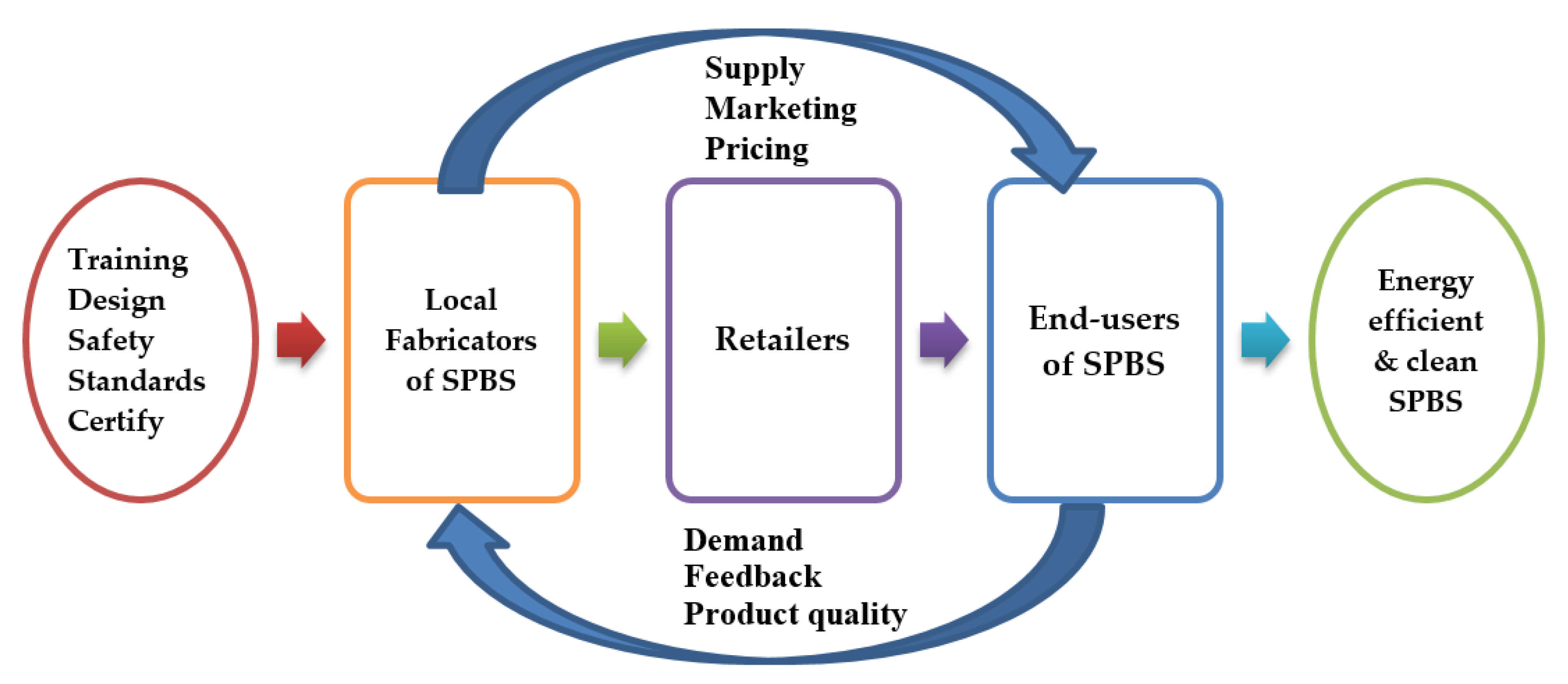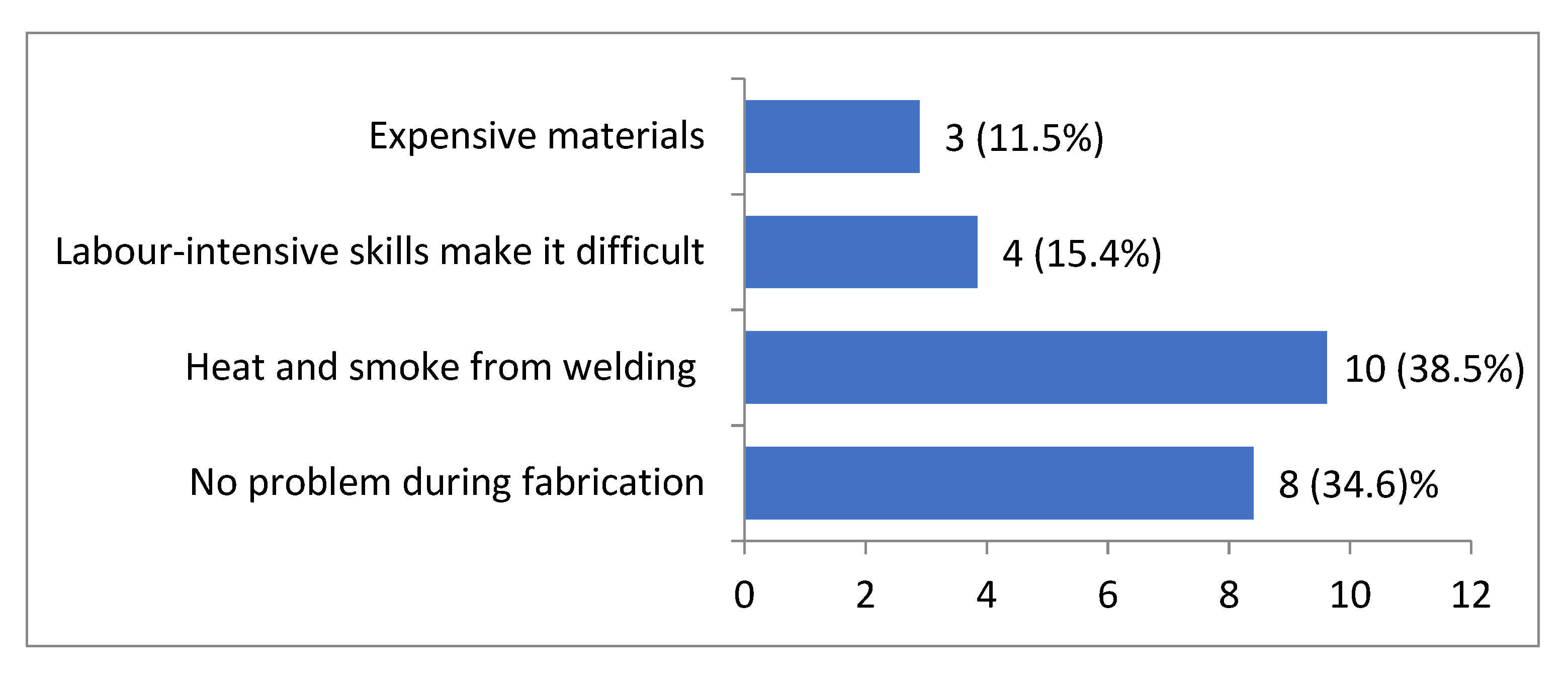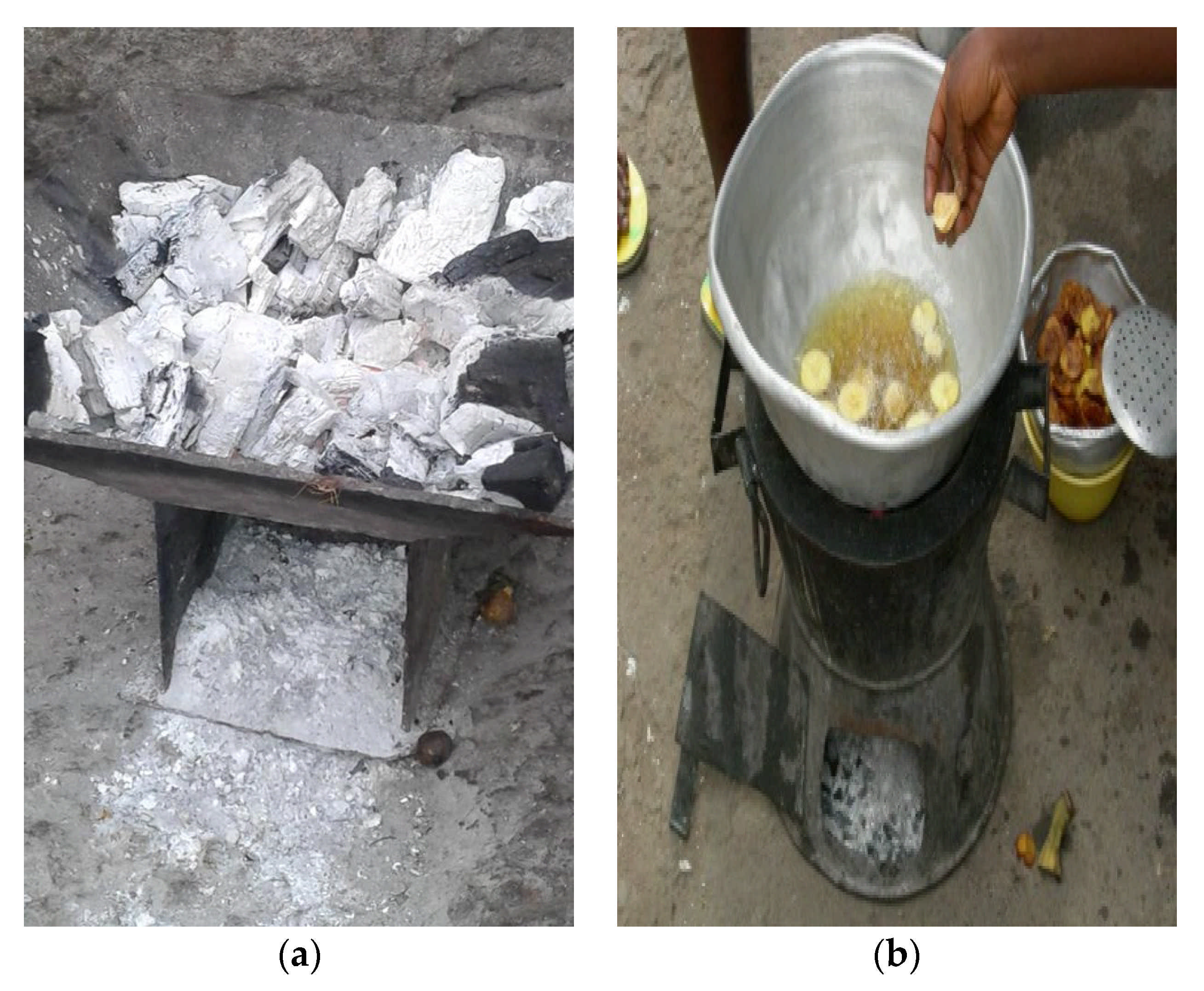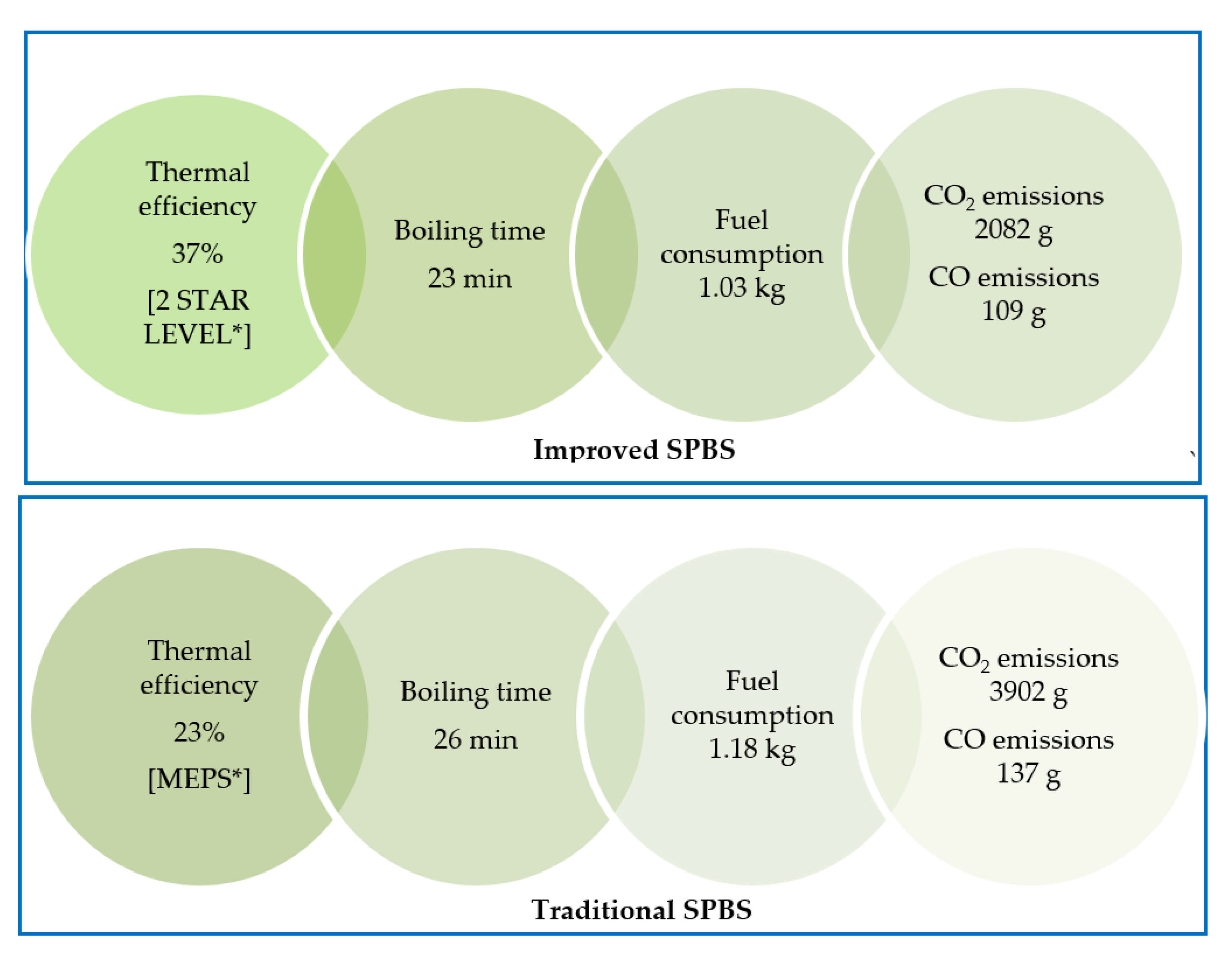Fabricators and End-Users of Single-Pot Biomass Stoves: Conceptualizing, Hypothesis and Performance Metrics for Developing Energy Sustainability Framework
Abstract
:1. Introduction
- (1)
- How do we conceptualize the relationship between local fabricators and end-users of SPBS for understanding and sustainable improvement?
- (2)
- What issues and challenges are faced by local fabricators and end-users of SPBS?
- (3)
- To what extent do smoke and heat affect local fabricators and end-users of SPBS and does heat and smoke effect have a relationship with gender?
- (4)
- How do we validate the performance metrics of SPBS?
- (5)
- What framework can be developed from the study to ensure sustainable energy management and product improvement?
2. Approach and Methodology
2.1. Survey of Local Fabricators and End-Users
2.2. Survey Data Analysis
2.3. Hypothesis Testing Using Chi-Square Test for Independence
2.4. Performance Testing
2.5. Development of Energy Sustainability Framework
3. Results and Discussion
3.1. Conceptualizing the Fabricator and End-User Relationship
3.2. The Fabricators
3.2.1. Design Challenges
3.2.2. Problems Faced during Fabrication
3.2.3. Safety Standards, Certification and Training
3.2.4. Marketing and Pricing
3.3. The End-Users
3.3.1. Stove and Fuel Stacking
3.3.2. Number of Stoves Used and Years of Usage (Durability)
3.3.3. Smoke and Ash Emissions
3.3.4. Managing Ashes from Single-Pot Biomass Cookstoves
3.4. Hypotheses Testing: Smoke and Heat Effect on Gender
3.5. Performance Metrics
3.6. Developing Energy Sustainability Framework
- (1)
- Social—The social aspects, perspectives and reflections contained in the information provided by the fabricators are characterized by low access to educational facilities, low earning capacity of the stove fabrication business, and lack of continuous training on stove design principles and standards. The implication is that end-users buy poorly designed stoves that give them less satisfaction with regard to energy efficiency, emissions and safety as poorly fabricated stoves are not properly insulated and so they lose a substantial amount of heat to the metal of the stove body as well as to the surroundings. Cooking with stoves that pose a safety risk is connected with a substantial share of the global burden of severe burns and injury occurring in low- and middle-income countries [8,45].
- (2)
- Economic—Data on economic aspects that were provided by the stove fabricators, which are captured in the framework include low equipment and tools utilization, use of scrap metals, less use of well-designed templates/patterns, and poor marketing and sales. Equipment and tools utilization is a measure of availability and how effectively they are used to produce the stoves within the time available to the fabricators. Traditional stove manufacturers tend to use basic hand tools such as hammers, chisels, files, clamps etc., to fabricate the stoves. Such tools are useful in the production of stoves; however, they are labor-intensive, slow to work with, and difficult to use as volume of production increases from small to medium and large scale. With regard to scrap metals, they are used principally because they are less costly compared to new sheet metals, which are not always readily available on the market, depending on the gauge. Typically, stove producers have patterns that are used for cutting of materials. However, they do not use the patterns for every cutting, particularly as they gain on-the-job experience with time. The result of such practice is that the parts are not of uniform standard and this affects interchangeability, which results in non-conformance to standards and low quality. Low quality products in turn attract low pricing and low market penetration. It is particularly important for manufacturers to understand the products that are preferred by consumers and hence, should be produced [46]. In general, end-users prefer affordable and clean cooking stoves of acceptable standard; hence, the transition from traditional cookstoves to clean cooking stoves is likely to enhance the income earning potential of local fabricators [47].
- (3)
- Environmental—The environmental aspects and perspectives from the standpoint of the fabricators include low environmental thoughts during fabrication; low awareness of indoor air pollution during heat treatment of scrap metals, particularly those who fabricate traditional SPBS using thicker gauge metals; and lack of instruments and testing devices for measuring and monitoring indoor emissions and energy efficiency. End-users are concerned with heat and smoke effects on their health, dirty cooking environment due to smoke emissions and fall of ashes on cooking area. Poorly fabricated stoves contribute to environmental challenges, and hence provide the justification for continuous development of emission efficient and clean SPBS.
- (4)
- Institutional—National level institutions responsible for the promotion, regulation and enforcement of clean cooking standards are less interested in the activities of local stove manufacturers; hence, they do not involve them in capacity development programmes and product certification to enhance their operations. However, it is said that the responsibility to guide on a sustainable path lies with resilient institutions to develop, train and retrain the human capital available [48,49]. Again, there is a lack of specific policy, plans and incentives for clean cooking stove development owing to the fact that stove fabricators are typically informal sector players who are not organized into formidable trade associations with a collective voice on issues that would significantly contribute to the growth of their business. End-user perspectives focused on concerns such as: lack of awareness of standards, incentives, and safety; no dialogue between end-users and institutions and the institutional challenge of relatively little emphasis on quality or performance testing and monitoring [50]. The energy sustainability framework presented in Figure 7 serves as a guide that provides information and opportunity for continuous research in clean energy cooking stove design, development and commercialization for sustainable production.
4. Conclusions and Recommendations
- (1)
- The relationship between fabricators and end-users of SPBS is conceptualized for understanding and quality improvement. Knowledge and information generated from the study will contribute to an optimal match of stove performance and end-user requirements that are considered important for performance improvement and achievement of clean energy efficiency. To improve quality and transition to clean energy stoves, templates and patterns being used should be created from engineering design that can be continually modified to reflect the changing needs of the market. Further, continuous training of local fabricators on measurements, drawings and specification and standards will help the fabricators to develop new stoves to achieve quality performance, safety, and aesthetics. In order to improve the quality of the stoves, fabricators should have access to modern equipment and tools, and be able to afford new materials for fabrication with good surface finish, which can result in good marketing and increased sales.
- (2)
- From the fabricators, issues that need to be solved include: heat and smoke effect from welding and heat treatment, low intensive-skills, low awareness of indoor air pollution during heat treatment of scrap metals of thicker gauge, and lack of instrumentation and testing devices for measuring and monitoring of indoor emissions and stove efficiency. The concerns of the end-users were: fuel and stove stacking, heat and smoke effects on their health, dirty cooking environment due to smoke emissions, and ash drops on cooking surroundings. To manage and dispose of charcoal ashes from biomass cooking stoves, four basic management practices were developed and presented.
- (3)
- From the hypothesis testing, it is concluded that heat and smoke effect have a relationship with gender. Hence, both male fabricators and female end-users must be protected in order that they can live healthy lifestyles free from heat and smoke associated with fabrication and use of stoves.
- (4)
- From the laboratory test results, the traditional SPBS emitted more CO and CO2 than the improved SPBS. The data suggest that traditional SPBS have more global warming impact than improved SPBS. Decades of lack of standards for local stove manufacture have resulted in emission concerns. Hence, there is a need for policies and programmes to support mandatory standards and enforcement to achieve enhanced design, fabrication and operational related outcomes.
- (5)
- An energy sustainability framework to ensure clean energy transition is developed out of which the following recommendations are made: (a) SPBS fabricators should work closely with end-users and other stakeholders to design stoves with well-structured features to obtain clean energy burning and high heat transfer; (b) design and fabrication of stoves should be guided by the goal of affordability, clean energy and low emissions; (c) there is the need to produce quality fabricated stoves and adopt innovative marketing strategies to get samples on the market; (d) continuous innovation in cleaner burning stoves and fuels is needed because such stoves have less global warming impact and, therefore, are the preferred choice for end-users.
- (6)
- Future research should consider the following: development of metrics to assess quality improvement efforts in design and fabrication of local stoves; model development for continuous quality improvement of SPBS; and optimization of design parameters to meet affordability, heat transfer and clean burning criteria.
Author Contributions
Funding
Institutional Review Board Statement
Informed Consent Statement
Data Availability Statement
Acknowledgments
Conflicts of Interest
References
- USAID. Clean and Efficient Cooking Technologies and Fuels: 5. Technological Innovation in Cookstoves and Fuels. A Publication Prepared by Winrock International for the Review of USAID; USAID/Winrock International, 2017. Available online: https://www.usaid.gov/sites/default/files/documents/1865/cookstoves-toolkit-2017-mod5-technological-innovation.pdf (accessed on 15 May 2020).
- Gitau, J.K.; Mendum, R.; Njenga, M. Gender and improvement of cooking systems with biochar-producing gasifier stoves. In Recovering Bioenergy in Sub-Saharan Africa: Gender Dimensions, Lessons and Challenges; Njenga, M., Mendum, R., Eds.; CGIAR Research Program on Water, Land and Ecosystems (WLE), Resource Recovery & Reuse: Colombo, Sri Lanka, 2018; 96p, ISBN 978-92-9090-877-7. [Google Scholar] [CrossRef]
- Adeya, N. Knowledge, Technology and Growth: The Case Study of Suame Manufacturing Enterprise Cluster in Ghana; Knowledge for development (K4D) Program; World Bank: Washington, DC, USA, 2006. [Google Scholar]
- Obeng, G.Y.; Mensah, E.; Ashiagbor, G.; Owusu, B.; Sweeney, D.J. Watching the Smoke Rise Up: Thermal Efficiency, Pollutant Emissions and Global Warming Impact of Three Biomass Stoves in Ghana. Energies 2017, 10, 641. [Google Scholar] [CrossRef] [Green Version]
- Raman, P.; Ram, N.K.; Murali, J. Improved test method for evaluation of bio-mass cook-stoves. Energy 2014, 71, 479–495. [Google Scholar] [CrossRef]
- Bantu, A.A.; Nuwagaba, G.; Kizza, S.; Turinayo, Y.K. Design of an Improved Cooking Stove Using High Density Heated Rocks and Heat Retaining Techniques. J. Ren. Energy 2018, 2018, 9620103. [Google Scholar] [CrossRef] [Green Version]
- Kodgule, R.; Salvi, S. Exposure to biomass smoke as a cause for airway disease in women and children. Curr. Opin. Allergy Clin. Immunol. 2012, 12, 82–90. [Google Scholar] [CrossRef] [PubMed]
- WHO. Household Air Pollution and Health. Key Facts; World Health Organisation (WHO): Geneva, Switzerland, 2018; Available online: https://www.who.int/news-room/fact-sheets/detail/household-air-pollution-and-health (accessed on 11 May 2020).
- Jerneck, A.; Olsson, L. A smoke-free kitchen: Initiating community based co-production for cleaner cooking and cuts in carbon emissions. J. Clean Prod. 2013, 60, 208–215. [Google Scholar] [CrossRef] [Green Version]
- Kshirsagar, M.P.; Kalamkar, V.R. User-centric approach for the design and sizing of natural convection biomass cookstoves for lower emissions. Energy 2016, 115, 1202–1215. [Google Scholar] [CrossRef]
- Kelly, M.; Donnelly, R.A. The Humongous Book of Statistics Problems; Penguin Group: New York, NY, USA, 2009; ISBN 978-1-59257-865-8. [Google Scholar]
- Lucey, T. Quantitative Techniques, 6th ed.; BookPower/ELTS: London, UK, 2002; ISBN 1-84480-111-X. [Google Scholar]
- Obeng, G.Y.; Adjaloo, M.K.; Amrago, D.K. Analysis of Skills and Training Needs of Metalwork Enterprises in Ghana. Int. J. Eng. Sci. 2013, 2, 102–112. [Google Scholar]
- WHO. Household Air Pollution and Health. Media Centre Fact Sheet N°292; World Health Organisation (WHO): Geneva, Switzerland, 2016; Available online: http://www.who.int/mediacentre/factsheets/fs292/en/ (accessed on 15 May 2020).
- Brew-Hammond, A.; Darkwah, L.; Obeng, G.; Kemausuor, F. Renewable Energy Technology, Capacity Building and R&D in Africa. Thematic Background Paper for International Conference on Renewable Energy in Africa. In Proceedings of the Jointly Organised by the Government of Senegal, the African Union, German Federal Ministry of Economic Cooperation and Development, Dakar, Senegal, 16–18 April 2008; Available online: http://energycenter.knust.edu.gh/downloads/5/52.pdf (accessed on 15 May 2020).
- GSA. Standards; Ghana Standards Authority (GSA): Accra, Ghana, 2016. Available online: http://www.gsa.gov.gh/ (accessed on 1 January 2016).
- GSA. GSA Standards Work Programme Bulletin January; Ghana Standards Authority (GSA): Accra, Ghana, 2016. [Google Scholar]
- Noelke, C.M.; Caswell, J.A. A Model of the Implementation of Quality Management Systems for Credence Attributes. In Proceedings of the Annual Meetings of the American Agricultural Economics Association, Tampa, FL, USA, 30 July–2 August 2000. [Google Scholar] [CrossRef]
- Smith, J. Protecting Health and the Planet with Clean Stoves Carbon Market Helps Boost African Energy Project. National Geographic News. 2011. Available online: http://news.nationalgeographic.com/news/energy/2011/02/110215-stoves-sustainable-development-ghana/ (accessed on 17 May 2020).
- World Bank. Household stoves, environment, health, and climate Change: A new look at an old problem. In The Environment Department (Climate Change); World Bank: Washington, DC, USA, 2011; Available online: http://documents.worldbank.org/curated/en/732691468177236006/pdf/632170WP0House00Box0361508B0PUBLIC0.pdf (accessed on 18 May 2020).
- Inkoom, D.K.B.; Biney, B.S. The potential of liquefied petroleum gas (LPG) as a viable energy option for the industrial sector in Ghana. J. Sustain. Dev. Afr. 2010, 12, 34–61. [Google Scholar]
- Prasad, B.; Baidurja, R.; Ravikrishna, R.V. Thermal Efficiency of LPG and PNG-fired burners: Experimental and numerical studies. Fuel 2014, 116, 709–715. [Google Scholar]
- WLPGA. World LPG Association Annual Report 2019; World LPG Association (WLPGA): Neuilly-sur-Seine, France, 2019; Available online: https://www.wlpga.org/wp-content/uploads/2019/12/WLPGA-Annual-Report-2019.pdf (accessed on 12 May 2020).
- Sander, P.J.; Haley, J. Value Investing for Dummies, 2nd ed.; Wiley Publishing Inc.: Indianapolis, IN, USA, 2008; ISBN 978-0-470-23222-4. [Google Scholar]
- InvestorWords. Disintermediation. 2002. Available online: http://www.investorwords.com/1488/disintermediation.html (accessed on 12 May 2020).
- PCIA. Test Results of Cook Stove Performance, Partnership for Clean Indoor Air (PCIA); Aprovecho Research Center, Shell Foundation, and United States Environmental Protection Agency: Cottage Grove, OR, USA, 2011. [Google Scholar]
- ESMAP. Beyond Connections Energy Access Redefined—Conceptualisation Report, Technical Report 008/15; Energy Sector Management Assistance Program (ESMAP) World Bank: Washington, DC, USA, 2015. [Google Scholar]
- Energypedia. Cooking Fuel. 2020. Available online: https://energypedia.info/wiki/Cooking_Fuels (accessed on 10 May 2020).
- EPA. Burn Wise. United States Environmental Protection Agency (US EPA); EPA: Washington, DC, USA, 2011. Available online: http://www.epa.gov/burnwise/healtheffects.html (accessed on 25 February 2016).
- Bruce, N.; Pope, D.; Rehfuess, E.; Balakrishnan, K.; Adair-Rohani, H.; Dora, C. WHO indoor air quality guidelines on household fuel combustion: Strategy implications of new evidence on interventions and exposure risk functions. Atmos. Environ. 2015, 106, 451–457. [Google Scholar] [CrossRef]
- Quinn, A.K.; Bruce, N.; Puzzolo, E.; Dickinson, K.; Sturke, R.; Jack, D.W.; Mehta, S.; Shankar, A.; Sherr, K.; Joshua, P.; et al. An analysis of efforts to scale up clean household energy for cooking around the world. Energy Sustain. Dev. 2018, 46, 1–10. [Google Scholar] [CrossRef] [PubMed]
- Wang, Y.; Bailis, R. The revolution from the kitchen: Social processes of the removal of traditional cookstoves in Himachal Pradesh, India. Energy Sustain. Dev. 2015, 27, 127–136. [Google Scholar] [CrossRef]
- ISO. ISO 19867-1:2018(en). Clean Cookstoves and Clean Cooking Solutions—Harmonized Laboratory Test Protocols—Part 1: Standard Test Sequence for Emissions and Performance, Safety and Durability. 2018. Available online: https://www.iso.org/obp/ui/#iso:std:iso:19867:-1:ed-1:v1:en (accessed on 18 May 2020).
- GACC. Cookstove Durability Testing. Global Alliance for Clean Cookstove (GACC). January 2013. Available online: https://www.cleancookingalliance.org/events/28.html (accessed on 18 May 2020).
- ENERGICA. Pre-Feasibility Study for an Improved Cook Stoves Project in Northern Ghana; Report submitted to CARE Denmark; Danish Energy Agency: Copenhagen, Denmark, 2009. [Google Scholar]
- Venkataraman, C.; Sagar, A.D.; Habib, G.; Smith, K. The national initiative for advanced biomass cookstoves: The benefits of clean combustion. Energy Sustain. Dev. 2010, 14, 63–72. [Google Scholar] [CrossRef]
- Urmeen, T.; Gyamfi, S. A review of improved Cookstove technologies and programs. Renew. Sust. Energ. Rev. 2014, 33, 625–635. [Google Scholar] [CrossRef] [Green Version]
- Demeyer, A.; Voundi Nkana, J.C.; Verloo, M.G. Characteristics of wood ash and influence on soil properties and nutrient uptake: An overview. Bioresour. Technol. 2001, 77, 287–295. [Google Scholar] [CrossRef]
- James, K.A.; Thring, W.R.; Helle, S.; Ghuman, S.H. Ash Management Review—Applications of Biomass Bottom Ash. Energies 2012, 5, 3856–3873. [Google Scholar] [CrossRef]
- Yu, Y.; Edze, P.; Spiak, M.; Kearney, N. Tier-Setting for Ghana Cookstove Labeling Program. CLASP. September 2017. Available online: http://eedal2017.uci.edu/wp-content/uploads/Wednesday-6-Yu.pdf (accessed on 16 May 2020).
- Bryden, M.; Still, D.; Scott, P.; Hoffa, G.; Ogle, D.; Bailis, R.; Goyer, K. Design Principles for Wood Burning Stoves; Aprovecho Research Center: Cottage Grove, OR, USA, 2011. [Google Scholar]
- GACC. The Water Boiling Test. Version 4.2.3. Cookstove Emissions and Efficiency in a Controlled Laboratory Setting. Global Alliance for Clean Cookstove (GACC) Released 19 March 2014. Available online: https://cleanstoves.org/binary-data/DOCUMENT/file/000/000/399-1.pdf (accessed on 15 May 2014).
- Still, D.; Bentson, S.; Lawrence, R.H.; Adams, E.; Andreatta, D.; Evitt, D.; Attenweiler, C.; Harris, K. Clean Burning Biomass Cookstoves, 2nd ed.; Aprovecho Research Center (ARC): Cottage Grove, OR, USA, 2021; Available online: http://aprovecho.org/publications-3/ (accessed on 31 May 2021).
- EPA. Air Quality Guide for Particle Pollution. Office of Air Quality and Radiation, February. (6301A) US EPA-456/F-15-005. 2015. Available online: www.airnow.org (accessed on 18 May 2020).
- Diekman, S.T.; Pope, D. WHO indoor air quality guidelines: Household fuel combustion. In Review 10: Burns and Poisoning; World Health Organization: Geneva, Switzerland, 2014. [Google Scholar]
- Han, Q.; Wang, Y. Decision and Coordination in a Low-Carbon E-Supply Chain Considering the Manufacturer’s Carbon Emission Reduction Behavior. Sustainability 2018, 10, 1686. [Google Scholar] [CrossRef] [Green Version]
- Brinkmann, V.; Klingshirn, A. Stove producers assess their impact. In Methodology and Results of a ProBEC Participatory Impact Assessment; Programme for biomass energy conservation (ProBEC), GTZ: Pretoria, South Africa, 2005. [Google Scholar]
- Ruiz-Mallén, I.; Heras, M. What Sustainability? Higher Education Institutions’ Pathways to Reach the Agenda 2030 Goals. Sustainability 2020, 12, 1290. [Google Scholar] [CrossRef] [Green Version]
- Association of African Universities. AAU Strategic Plan 2016–2020 (August 2016). Available online: https://www.aau.org/wp-content/uploads/sites/9/2016/10/AAU-STRATEGIC-PLAN-2016-2020-FINAL.pdf (accessed on 31 May 2021).
- World Bank. Accelerating Access to Clean Cooking: The Efficient, Clean Cooking and Heating Program and the Clean Cooking Fund, Results Brief; World Bank: Washington, DC, USA, 2020; Available online: https://www.worldbank.org/en/results/2020/11/10/accelerating-access-to-clean-cooking-the-efficient-clean-cooking-and-heating-program-and-the-clean-cooking-fund (accessed on 1 June 2021).







| Fabricator Level Indicators | Assumptions |
|---|---|
|
|
| End-User Level Indicators | Assumptions |
|
|
| Designing Stoves before Production | |||
|---|---|---|---|
| Frequency | Valid (%) | Cumulative (%) | |
| Stoves designed before production | 15 | 60.0 | 60.0 |
| Not designed before production | 10 | 40.0 | 100.0 |
| Sample size (n) | n = 25 | 100.0 | |
| Procedures for Designing | |||
| Patterns and templates | 14 | 56.0 | 56.0 |
| Not applicable | 11 | 44.0 | 100.0 |
| Sample size (n) | n = 25 | 100.0 | |
| Safety Standards Followed during Fabrication | |||
|---|---|---|---|
| Frequency | Valid (%) | Cumulative (%) | |
| Follow safety standards | 2 | 8.0 | 8.0 |
| Do not follow safety standards | 23 | 92.0 | 100.0 |
| Certification by Relevant Authorities | |||
| Certified | 1 | 4.0 | 4.0 |
| Not certified | 24 | 96.0 | 100.0 |
| Training on Standards and Safety of Stoves | |||
| Trained on standards and safety | 1 | 4.0 | 4.0 |
| No training on standards and safety | 24 | 96.0 | 100.0 |
| Sample size (n) | n = 25 | ||
| Mean Stoves Sold Per Week | Min | Max | Mean | Standard Deviation | 95% Confidence Interval for the Mean | Sample Size (n) | |
|---|---|---|---|---|---|---|---|
| Lower bound | Upper bound | ||||||
| Small-size | 3 | 100 | 48.19 | 40.55 | 31.81 | 64.57 | n = 25 |
| Medium-size | 2 | 100 | 42.61 | 38.36 | 27.12 | 54.11 | |
| Large-size | 2 | 70 | 18.88 | 16.99 | 11.87 | 25.89 | |
| Price of Stoves | ||
|---|---|---|
| Type of Single-Pot Biomass Stove | Price (US Dollars) | |
| Charcoal stove (coalpot)—small | US$5.2–10 | |
| Charcoal stove (coalpot)—medium | US$6.5–13 | |
| Charcoal stove (coalpot)—large | US$16–20 | |
| LP gas stove | US$13–26 | |
| Improved cookstove (Gyapa) | US$4–7 | |
| Means of Getting Customers to Buy Stoves | ||
| Word of mouth | 10 | 40.0% |
| Samples are sent to the market | 15 | 60.0% |
| Retail Outlets for Stoves | ||
| Fabrication shop | 6 | 24.0% |
| Local market | 14 | 56.0% |
| Shop and local market | 5 | 20.0% |
| Sample size (n = 25) | ||
| Number of SPBS Used | Years of Usage * | ||||
|---|---|---|---|---|---|
| Traditional Stoves | |||||
| Frequency | Valid % | 3–7 | 8–11 | 12–15 | |
| One stove | 6 | 40% | 40% | 13% | 13% |
| Two stoves | 5 | 33% | Improved Stoves | ||
| Three stoves | 4 | 27% | 1–4 | 5–10 | 11–15 |
| Sample size (n) | n = 15 | 67% | 33% | none | |
| Smoke during Cooking | ||
|---|---|---|
| Traditional stoves | Improved stoves | |
| Affected by smoke during cooking | 9 (60%) | 1 (6.7%) |
| Not affected by smoke during cooking | 6 (40%) | 8 (93.3%) |
| Ashes around Cooking Area | ||
| Stove produces charcoal ashes | 9 (60%) | 2 (22%) |
| Stove does not produce charcoal ashes | 6 (40%) | 7 (78%) |
| Sample size (n) | n = 15 | |
| Awareness of Environmental Changes | ||
| Frequency | Valid (%) | |
| Aware of environmental changes | 12 | 80.0 |
| Not aware of environmental changes | 3 | 20.0 |
| Sample size (n) | n = 15 | |
| Affected by Heat and Smoke (during Fabrication) | Not Affected by Heat and Smoke (during Cooking) | Total | |
|---|---|---|---|
| fabricators | 10 | 15 | 25 |
| End-users | 7 | 8 | 15 |
| Total | 17 | 23 | 40 |
| Row | Column | O | E | O−E | (O−E)2 | |
|---|---|---|---|---|---|---|
| 1 | 1 | 10 | 10.63 | −0.63 | 0.3969 | 0.03733772 |
| 1 | 2 | 15 | 14.38 | 0.62 | 0.3844 | 0.02673157 |
| 2 | 1 | 7 | 6.38 | 0.62 | 0.3844 | 0.06025078 |
| 2 | 2 | 23 | 8.63 | 14.37 | 206.497 | 23.9277984 |
| TOTAL | 24.0521185 | |||||
Publisher’s Note: MDPI stays neutral with regard to jurisdictional claims in published maps and institutional affiliations. |
© 2021 by the authors. Licensee MDPI, Basel, Switzerland. This article is an open access article distributed under the terms and conditions of the Creative Commons Attribution (CC BY) license (https://creativecommons.org/licenses/by/4.0/).
Share and Cite
Obeng, G.Y.; Mensah, E.; Opoku, R. Fabricators and End-Users of Single-Pot Biomass Stoves: Conceptualizing, Hypothesis and Performance Metrics for Developing Energy Sustainability Framework. Sustainability 2021, 13, 7098. https://doi.org/10.3390/su13137098
Obeng GY, Mensah E, Opoku R. Fabricators and End-Users of Single-Pot Biomass Stoves: Conceptualizing, Hypothesis and Performance Metrics for Developing Energy Sustainability Framework. Sustainability. 2021; 13(13):7098. https://doi.org/10.3390/su13137098
Chicago/Turabian StyleObeng, George Yaw, Ebenezer Mensah, and Richard Opoku. 2021. "Fabricators and End-Users of Single-Pot Biomass Stoves: Conceptualizing, Hypothesis and Performance Metrics for Developing Energy Sustainability Framework" Sustainability 13, no. 13: 7098. https://doi.org/10.3390/su13137098
APA StyleObeng, G. Y., Mensah, E., & Opoku, R. (2021). Fabricators and End-Users of Single-Pot Biomass Stoves: Conceptualizing, Hypothesis and Performance Metrics for Developing Energy Sustainability Framework. Sustainability, 13(13), 7098. https://doi.org/10.3390/su13137098





